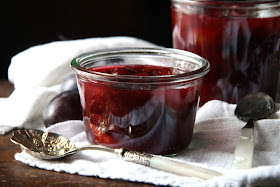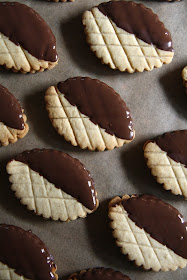Last weekend I made pizza on the grill for the first time this summer. I know, that's crazy, right? Hours before I shared what the plan for dinner would be did I learn my pizza stone had somehow managed to get broken. Apparently it broke all on it's own. Now that's even crazier, right? In a rare 'just go buy a new one' comment from the person who shall remain nameless, I didn't waste the opportunity. It just so happened we were near Williams-Sonoma at the time (there is one less than 4 miles from my house). Rather than get the same 'magically breaks on its' own' one I had before, I decided to go big this time and get an Emile Henry pizza stone. Ever since I first saw one, I had wanted it but couldn't bring myself to indulging myself into buying something really nice versus need to have. So having now made a somewhat sizable investment (relatively speaking) investment in a great new pizza stone, I feel like homemade pizza on the grill (or in the oven) should start becoming a regular thing around here. This would be my irrational way of justifying the cost way of thinking. With tomatoes still in season, the simple fresh tomato, mozzarella, fresh herb, garlic, pesto, drizzled with olive oil pizza made on new pizza stone on the grill turned out to be amazing! And hunger had absolutely nothing to do with the collective opinion on the taste or texture of the pizza. It really was crazy good. So this week I am having some of my friends and am, guess what? I am making pizza on the grill! Fingers crossed the second pizza is as good as or better than the first one! Because I always like to have something sweet or a dessert to serve when I have people over, I decided I would make the Scotcheroos 2.0 too. Considering one of my friends is from the land of hot dish and Scotcheroos (aka Minnesota) the timing for making them was perfect. Being able to have someone re-connect with a childhood memory gives me a certain kind of thrill.
Scotcheroos have been described as a Rice Krispie Bar on steroids. Bordering closer to a candy bar than a dessert bar, a recipe for Scotcheroos was originally printed on a box of Rice Krispies cereal back in the 1960s. Today, they evoke a kind of nostalgic experience for those us growing up with them. Peanut butter, butterscotch, and chocolate combined with Rice Krispies (or other crisped rice cereal) create a melt-in-your-mouth kind of lusciousness not found in any other 'cereal' bar confection. Midwesterners may have a special affinity for Scotcheroos, however, they have found their way into kitchens across the country for past fifty plus years. If for some reason, Scotcheroos never made it to your neck of the woods, you have been missing out. No-bake Scotcheroos generally start making their appearance at pot-lucks, family gatherings, and afternoon snack trays in the fall, when the weather begins to cool.
The original recipe for Scotcheroos were made with just six ingredients: granulated sugar, peanut butter, corn syrup, Rice Krispies cereal, semi-sweet chocolate chips, and butterscotch chips. Over the past fifty years, multiple variations of this beloved bar have emerged. The most common one replaces semi-sweet chocolate chips with milk chocolate chips. However, it wasn't until I stumbled across Sarah Kieffer's Scotcheroos recipe did I learn light brown sugar is a great replacement for granulated sugar; vanilla and salt are great flavor boosters; and, butterscotch chips should be melted into the peanut butter rather than in the semi-sweet chocolate for a more epic Scotcheroo! The ingredient alterations in this Scotcheroos recipe, which I am affectionately calling Scotcheroos 2.0, are not only genius, they take this classic bar to a whole new level of addictive oh-em-gee deliciousness.
Measuring out all of the ingredients before you begin making the Scotcheroos makes the process go smoothly and easily. And using a large, heavy bottomed pan makes this one-pot wonder a breeze to assemble.
Not only does brown sugar bring a deeper flavor to these Scotcheroos, melting the butterscotch chips in with the peanut butter surprisingly brings some balance to all of the sweetness in the bars bottom layer. After bringing the brown sugar, corn syrup, and salt to a boil, the pan is removed from the heat. Working quickly the peanut butter and butterscotch chips are stirred into the hot mixture until everything has melted. After a quick stir in of the vanilla, the already measured out Rice Krispies are added in. As with making Rice Krispie treats, you will get a bit of an upper arm workout getting everything evenly mixed together before transferring to your prepared pan.
For the record, I am HUGE fan of lining all of my baking pans with parchment paper. More often than not I am dismissive of most recipes calling for lightly buttering a pan, choosing instead to use the 'makes removal from the pan a cinch' parchment paper. Being able to lift a pan of brownies or Scotcheroos out of the pan without incident is one of those little things in life making me happy.
Melted semi-sweet chocolate topped this pan of Scotcheroos although I gave some thought to topping it with a combination of melted milk and semi-sweet chocolate. While I am still tinkering with the idea of combining those two chocolates, I would definitely recommend lightly sprinkling the semi-sweet chocolate layer with flaky sea salt. To prevent the sea salt from melting into the warm/hot chocolate, wait at least 7-9 minutes to sprinkle it on (the chocolate will not have set up by then but will have started to cool down).
To keep as much as the chocolate's shine as possible, I did not put the pan of Scotcheroos in the refrigerator to speed up the setting up process.
Decadent and rich are two words one might also use when describing Scotheroos. So when you cut them into bars or squares, think smaller rather rather than larger. It was only after I cut the pan into two inch squares that I had 'ah-ha' moment.
I made several changes to Sarah's recipe. I used 6 1/2 cups of Rice Krispies cereal instead of 6 cups because the mixture seemed to call for it; used slightly more than a pound of semi-sweet chocolate chips instead of 6 ounces because I wanted a thick layer of chocolate on top; used an 8" x 12" pan instead of 9" x 9" pan because I wanted the bars to be less chunky; and, finished the Scotcheroos off with a light sprinkling of sea salt, well because, sea salt and chocolate are a combination almost impossible to resist. Feel to make either this slightly altered adaptation of Sarah's version, but make one of them. I would be willing to bet you will fall deeply, madly in love with either one or both. If, by some chance you have lived managed to live a Scotcheroo-free life or it has been years since you have had one, now is the time to change that. And whether it will be your first time or not, these are what Scotcheroos were always meant to be.
Scotcheroos 2.0 (a slight variation to Sarah Kieffer's (Handmade Charlotte) Scotcheroos recipe)
Ingredients
1 cup corn syrup
1 cup (225 g) light brown sugar, firmly packed
Pinch of sea salt
1 cup creamy peanut butter
6 ounces (172g) butterscotch chips
1 teaspoon vanilla
6 to 6 1/2 cups (150-163g) Rice Krispies cereal
2 1/2 cups (485g) semi-sweet chocolate, milk chocolate, or a combination of semi-sweet and milk chocolate chips or good quality melting chocolate (See notes below)
Flaky sea salt for finishing (optional, but a perfect finishing touch to compliment the semi-sweet chocolate layer)
Directions
1. Line an 8"x 13" or 9"x 12" or 9"x 9" metal pan with parchment paper. Set aside. (See notes below)
2. In a heavy bottomed pan, add corn syrup, brown sugar, and salt. Bring to a boil over medium heat.
3. Remove pan from heat and immediately add in the butterscotch chips and peanut butter. Stir until everything has completely melted. Note: It's okay if there are a few tiny bits of butterscotch chips.
4. Stir in vanilla.
5. Add in Rice Krispies, stirring with a spatula or wooden spoon until everything is well blended.
6. Scrape the mixture into the prepared pan. Press in firmly.
7. Melt the chocolate using either the microwave or double-boiler method.
8. Pour the melted chocolate over the Rice Krispies mixture. Smooth with an offset spatula.
9. Let chocolate set for 7-9 minutes before lightly sprinkling the pan with flaky sea salt.
10. Allow the chocolate to completely set before cutting into bars or squares
11. Well wrapped the Scotcheroos will last for up to a week.
Notes: (1) The amount of chocolate you will need for the Scotcheroos will be affected by the size of the pan used. I used an 8"x13" vintage pan and 2 1/2 cups of chocolate chips covered the pan, giving the Scotcheroos the prefect 'in my world' bar to chocolate ratio. If using the larger pan 9"x12" you may need to increase the amount of chocolate by 1/2 cup or to a total of 3 cups. If using the smaller 9"x9" reduce the amount of chocolate to 1 1/4-1 1/2 cups. (2) I used semi-sweet chocolate chips, however, I will more than likely blend semi-sweet and milk chocolate chips on the next batch to decide which combination I like best. (3) I used JIF creamy peanut butter and Ghiradelli (60% cocoa) chocolate chips.


























































